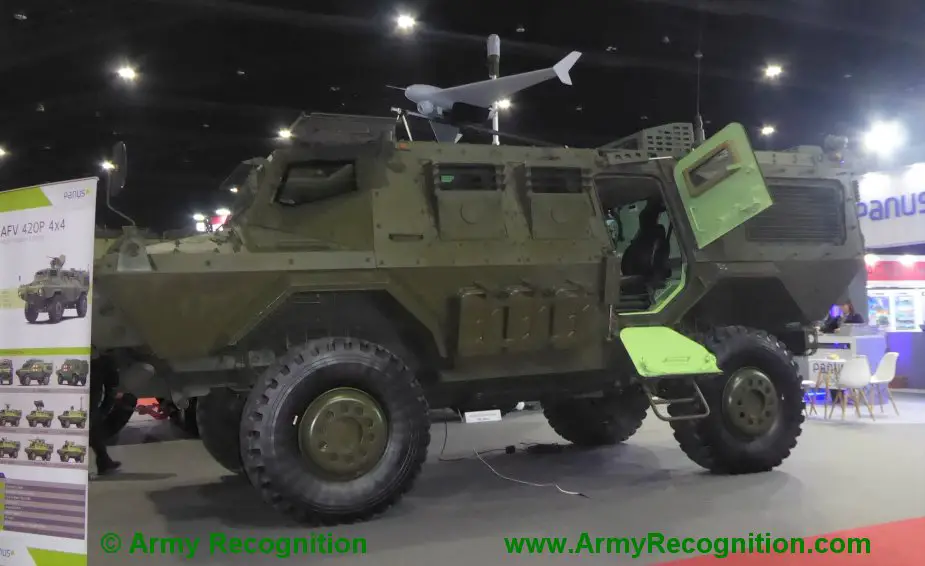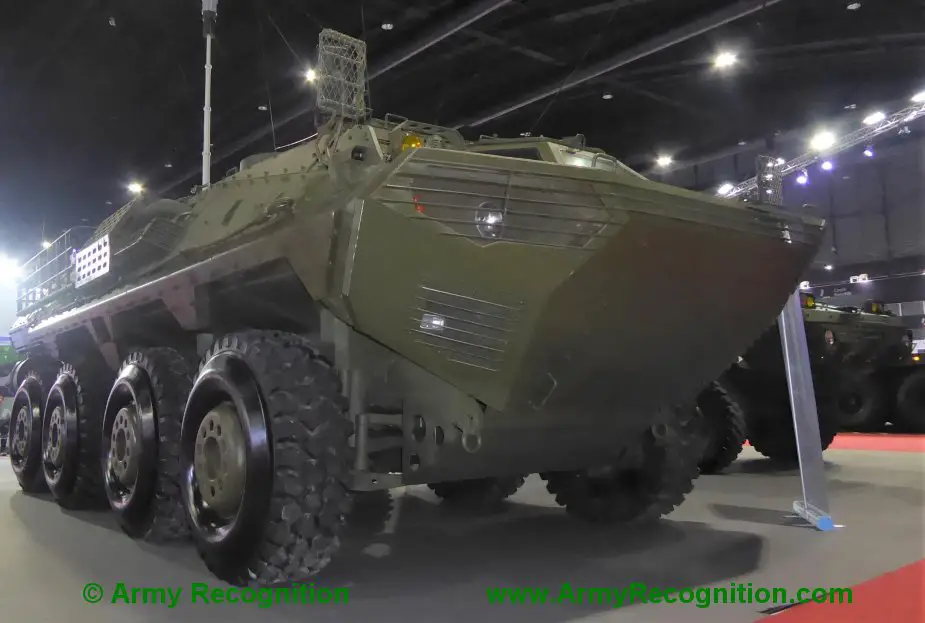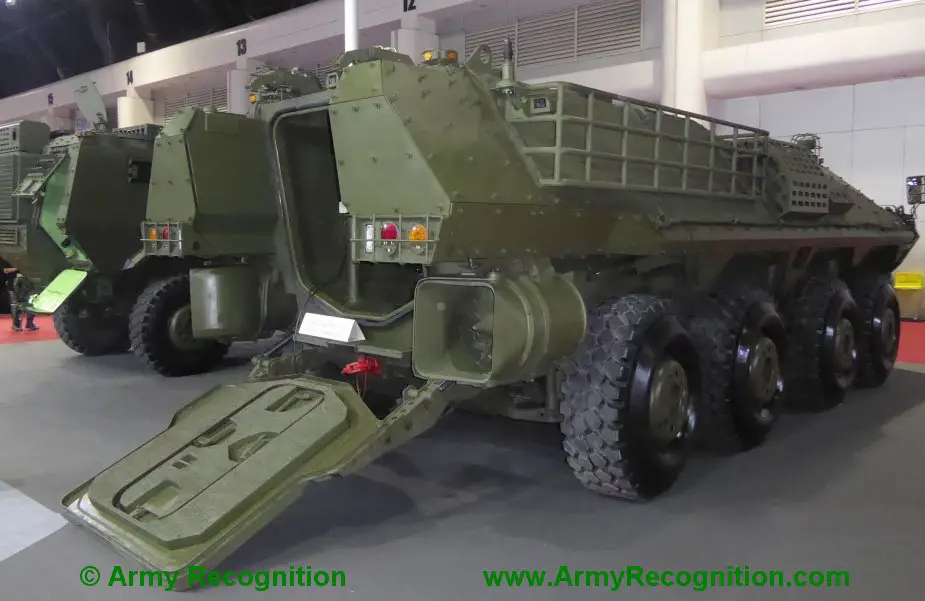Breaking news
Defense & Security Thailand 2019: Panus showcases AFV-420P and R600 armored vehicles.
Thai company Panus Assembly Co. Ltd is showcasing the AFV-420P, the latest version of its 4×4 armored vehicles based on HMV-420 that it hopes to supply to the Royal Thai Armed Forces. The company also showcases its 8x8 R600 amphibious Infantry Fighting Vehicle prototype. The story of this vehicle family is particularly interesting.

AFV-420P is displayed with a drone based on its roof (Picture source: Army Recognition)
Somsak Nonpoe, Government Project Director, told the particularly interesting story of the HMV-20 that led to the development of the R600. Initially, Panus delivered two units of an MRAP vehicle to a Marine unit in the south of the country. There, the company representative saw two wrecks of old Cadillac Gage V-150 Commando vehicles blown up on mines. Instead of seeing them scrapped, Panus obtained to completely restore them in a combat condition. Using the experience gathered from this work, the company designed its own vehicle - the AFV-420 - that benefited from many improvements, the most noticeable one being a great four-wheel steering system enabling the vehicle to maneuver through deeply forested areas and narrow village streets. This is amazingly the only armored vehicle of its kind that benefits from this crucial ability.
Following a series of tests conducted in 2018 at the Department of Army Transportation in Kanchanaburi Province and taking into account the input from the army requesting a special layer of armor emerged the new “Mosquito” 4×4 AFV-420P vehicle, Military Leaks reports. The HMV-420 high mobility vehicle (HMV) is based on the company’s HMV-150 platform, which was unveiled in 2017 and, in turn, is based on a re-engineered and upgraded Cadillac Gage V-150 Commando 4×4 light armored vehicle dating back to the Vietnam War era. Panus wants to produce and export the AFV-420P.
The AFV-420P platform is used for variants such as APC, radar vehicle, command and communication vehicles, etc. The axle shafts have been replaced with larger ones and the tires are enlarged so that the vehicle is slightly higher. This vehicle has a length of 6.72 m, a width of 2.86 m, a height of 2.98 m, a ground clearance is 0.61 m. It can reach 110 km/h. The turning radius is minimal thanks to its 4-wheel steering system. The AFV-420P has a weight of 15.84 tons, with a payload of 1.5 tons. The newer product sports better protection and more internal space for its occupants and installed weapons while being powered by a Cummins diesel unit of 420 horsepower output associated with an Allison 4500 automatic gearbox.
The Mosquito can accommodate a remotely controlled weapon station of a more conventional turret armed with a 12.7 mm caliber MG and/or missile launcher(s). At Defense & Security Thailand 2019, even a drone is associated to the vehicle, a more and more common option. Firing ports are positioned along the sides of the hull to allow occupants to engage outside enemy elements from within the protected confines of the truck. Armor protection is up to small arms fire and artillery spray but mobility is at the heart of such designs. Attention has also been given to enhanced protection against Improvised Explosive Devices (IEDs) and land mines common to urban fighting. Armor reaches up to 16mm at crucial facings through a double-layer steel configuration. Steel layers can be added to protect the personnel and engine compartments against 12.7 mm caliber ammunition and schrapnels.

Panus AFV-420P is displayed with a drone based on its roof (Picture source: Army Recognition)

Panus R600, 8x8 and 8-wheel steering amphibious IFV developed at the Royal Thai Marine Corps' request, here in a command post version. The eight run-flat tires are protected by Hutchinson's Tire Shield system (Picture source: Army Recognition)
Panus R600
After the AFV-420 was tested, the Marine Corps asked Panus if they could develop an 8x8 armored vehicle, also benefiting from the all-wheel steering system and made amphibious, the propulsion being carried on by water jets. And Panus made it. So, designed and built in Thailand for the Thai Marine Corps, the R600 prototype was tested for the first time at the vehicle testing ground of the Royal Thai Marine Corps, Royal Thai Navy at Royal Thai Army's Vehicle Test Range in Kanchanaburi province on 28 August 2019. Only after these basic tests were the internal equipment and weapon systems installed in the vehicle. The 30mm turret is manufactured by the Turkish company ASELSAN. The hull is made in China. Panus doesn't want to fight its way among the biggest defense companies but is proud to state that it can fulfill any specific need expressed by a customer.
The R 600 weighs 25 tons, is 8.4 meters long, 3.2 meters wide, 2.75 meters high. The ground clearance is 500 mm. The Cummins engine develops 600 hp and is coupled to an Allison 4500 6-speed automatic transmission. The power to ratio rate is 24hp/t. The 8-wheel steering vehicle can drive either in 8x4 or 8x8.
It can overcome a 60cm vertical obstacle, a 40% slope, and a 60% grade ramp. The top speed on-road is 110 km/h, 14 km/h on water. The operating range is 800 km. The IFV can accommodate 2 crew members and 20 people. The protection level is Stanag 4569 LV.2, or Lv.3 in option.
Panus tested its newest product R600 8x8 wheeled Infantry Fighting Vehicle (IFV) prototype at the Royal Thai Marine Corps, Royal Thai Navy at Royal Thai Army's Vehicle Test Range in Kanchanaburi province from 28 August 2019 onwards.

The Panus R600 is amphibious. The propulsion on the water works with water jets (Picture source: Army Recognition)


























